HOME | DD
 doublejota — Signal repeaters
doublejota — Signal repeaters

Published: 2021-11-12 21:10:02 +0000 UTC; Views: 5837; Favourites: 68; Downloads: 6
Redirect to original
Description
Radioscriptorans are a taxon of gemellates characterized by the use of radio signals for the communication between individuals of their colonies, which are transmitted very poorly underwater. This is not a problem for most radioscriptorans since the individuals in the colony remain very close to each other, separated by a few millimeters or centimeters, so they receive a good signal. However, in the case of many hive sponges (Scleralvearia) they need their drones to travel long distances from the queen in search of food. Even if the queen emits low-frequency signals, drones have trouble picking up the signal beyond a few square meters. For these reasons, many hive sponges have developed special drones with the function of serving as signal repeaters, emitting the same signals as the queen and expanding the exploration area of the drones without fear of getting lost. These structures must be well protected, since if one fails, all drones located within its range could lose the queen's signal and get lost, starving to death. Since these repeater drones cannot return to the queen for food, they need another specialized caste of drones in charge of transporting them the queen's nourishing nectar.
This adaptation is so useful that it has evolved convergently in at least seven different lineages of unrelated hive sponges. In the image you can see three examples:
-Upper Image: Characteristic of the family Chrysoporidae. They live slowly crawling over the reefs, being strongly protected by an exoskeleton. Their ability to move a few meters per day allows them to vary the exploration area of the colony, in order to search for new foraging areas.
-Bottom left image: Formicoporus repeater drone (3 cm). In this genus the drones have modified a row of fins to allow them dig into soft, sandy bottoms, where it remains buried or semi-buried emitting the signal. In case their hiding place does not work, they can flee by swimming relatively quickly.
-Down right. Repeater drone characteristic of Dolichoporidae, with a completely sessile lifestyle. They perforate the exoesqueleton of other hive sponges and use it as a burrow. In case of danger they hide and seal the entrance with two lid shaped organs.
Related content
Comments: 6

👍: 0 ⏩: 0

👍: 0 ⏩: 1

👍: 0 ⏩: 1

👍: 0 ⏩: 1

👍: 0 ⏩: 1

👍: 0 ⏩: 0

























